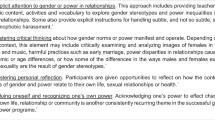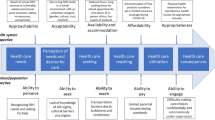Abstract
Despite revising their reproductive health policies in line with the 1994 International Conference on Population and Development (ICPD) Programme of Action, a major challenge facing many developing countries is the inability to fully implement the policies owing to lack of funds, bureaucratic delays, and limited awareness among various stakeholders. In some countries, the policies fail to adequately address sexual and reproductive health (SRH) needs of vulnerable groups. This study examines the barriers to SRH programming for adolescents living with HIV from the perspectives of key stakeholders involved in SRH issues in Uganda. The data are from qualitative interviews conducted in 2007 with 23 key informants from bilateral institutions, government ministries, and civil society organizations. The study findings confirm that policy and programmatic gaps exist in addressing the SRH needs of HIV-positive adolescents. This is attributable to: (1) lack of clear guidelines on how to address the SRH of HIV-positive adolescents; (2) challenges of dealing with adolescent SRH in general; (3) HIV/AIDS treatment, care, and support services that are either pediatric- or adult-oriented; and (4) limited institutional and provider capacity to offer SRH services to HIV-positive adolescents despite recognizing that this is an emerging area that requires intervention. These results suggest the need for: (1) clear guidelines on dealing with SRH of HIV-positive adolescents; (2) establishing transition clinics or youth-friendly corners to cater for the needs of adolescents who cannot fit in either pediatric or adult clinics; and (3) providing training and reorientation on SRH of HIV-positive adolescents to service providers/counsellors.
Similar content being viewed by others
References
African Youth Alliance. (2001). Review of laws, policies, strategies and guidelines relevant to adolescent sexual and reproductive health and HIV/AIDS in Uganda. Uganda: UNFPA, PATH & PATHFINDER.
Allen, T. (2006). AIDS and evidence: Interrogating some Ugandan myths. Journal of Biosocial Science, 38(1), 7–28.
Bakeera-Kitaka, S., Nabukeera-Barungi, N., Nöstlinger, C., Addy, K., & Colebunders, R. (2008). Sexual risk reduction needs of adolescents living with HIV in a clinical care setting. AIDS Care, 20(4), 426–433.
Birungi, H., Mugisha, J. F., Nyombi, J., Obare, F., Evelia, H., & Nyinkavu, H. (2008). Sexual and reproductive health needs of adolescents perinatally infected with HIV in Uganda. FRONTIERS Final Report. Washington, DC: Population Council.
Birungi, H., Mugisha, J. F., Obare, F., & Nyombi, J. (2009a). Sexual behaviour and desires among adolescents perinatally infected with HIV in Uganda: Implications for programming. Journal of Adolescent Health, 44(2), 184–187.
Birungi, H., Obare, F., Mugisha, J. F., Evelia, H., & Nyombi, J. (2009b). Preventive service needs of young people perinatally infected with HIV in Uganda. AIDS Care, 21(6), 725–731.
Brock, K., McGee, R., & Ssewakiryanga, R. (2002). Poverty knowledge and policy processes: A case study of Ugandan national poverty reduction policy. Research Report 53. Sussex: Institute of Development Studies.
Glenngård, A. H., & Maina, T. M. (2007). Reversing the trend of weak policy implementation in the Kenyan health sector? A study of budget allocation and spending of health resources versus set priorities. Health Research Policy and Systems, 5, 3.
Haines, A., Kuruvilla, S., & Borchert, M. (2004). Bridging the implementation gap between knowledge and action for health. Bulletin of the World Health Organization, 82(10), 724–732.
Hardon, A. (2005). Confronting the HIV/AIDS epidemic in sub-Saharan Africa: Policy versus practice. International Social Science Journal, 57(186), 601–608.
Innvaer, S., Vist, G., Trommald, M., & Oxman, A. (2002). Health policy-makers’ perceptions of their use of evidence: A systematic review. Journal Health Services Research and Policy, 7(4), 239–244.
Ministry of Gender, Labour, Social Development [Uganda]. (2001). The National Youth Policy. Kampala, Uganda: Ministry of Gender Labour and Social Development.
Ministry of Health [Uganda]. (1998). Sexual and reproductive health minimum package. Kampala, Uganda: Ministry of Health.
Ministry of Health [Uganda]. (2006). The National Policy Guidelines and Service Standards for sexual and reproductive health and rights. Kampala, Uganda: Ministry of Health.
Neema, S., Musisi, N., & Kibombo, R. (2004). Adolescent sexual and reproductive health in Uganda: A synthesis of the research evidence. Occasional Report No. 14. New York: The Alan Guttmacher Institute.
Parent, F., Fromageot, A., Coppieters, Y., Lejeune, C., Lemenu, D., Garant, M., et al. (2005). Analysis of adequacy levels for human resources improvement within primary health care framework in Africa. Health Research Policy and Systems, 3, 8.
Philpott, A., Maher, D., & Grosskurth, H. (2002). Translating HIV/AIDS research findings into policy: Lessons from a case study of ‘the Mwanza trial’. Health Policy and Planning, 17(2), 196–201.
Tantchou, J., & Wilson, E. (2000). Post-Cairo reproductive health policies and programs: A study of five Francophone African Countries. Washington, DC: The Futures Group International.
United Nations Department of Public Information (UN/DPI). (1995). ICPD ‘94: Summary of the programme of action. Proceedings of the 1994 international conference on population and development, Cairo.
World Bank. (2001). Capacity strengthening in environmental and natural resource policy: Lessons from Malawi. Findings, 182.
Acknowledgements
The project on the sexuality of young people perinatally infected with HIV in Uganda that provided the data for this paper was funded by the Ford Foundation and the United States Agency for International Development (USAID). The AIDS Support Organization (TASO)—Uganda implemented the study while the Population Council—Nairobi provided technical support. We also acknowledge the support of the research team including the late John Frank Mugisha, the HIV/AIDS treatment, care and support centers, the research assistants, and the study participants toward the successful implementation of the project. The views expressed in the paper are, however, those of the authors and do not necessarily reflect the views of the implementing or funding agencies.
Author information
Authors and Affiliations
Corresponding author
Rights and permissions
About this article
Cite this article
Obare, F., Birungi, H. & Kavuma, L. Barriers to Sexual and Reproductive Health Programming for Adolescents Living with HIV in Uganda. Popul Res Policy Rev 30, 151–163 (2011). https://doi.org/10.1007/s11113-010-9182-1
Received:
Accepted:
Published:
Issue Date:
DOI: https://doi.org/10.1007/s11113-010-9182-1




